Science has advanced where we get to hear interesting news every day. It’s a marvel of human use of technology to discover and invent processes to combat disease. Whenever such a feat is reached, the scientists think they have finally finished the job. But this is always unnecessary. Just like two decades ago, scientists thought they have decoded the human genome, which was a scientific milestone. This is not the case. Scientists have published the first human genome, which will help the health sector. They have published six papers in the Journal of Science.
Today is the big day! The #T2T consortium is claiming victory and announcing that we have finally uncovered every last bit of the human genome! The papers are out today 🥳🧬 https://t.co/m8wgy09JBs pic.twitter.com/mS11WX1Sof
— Adam Phillippy (@aphillippy) March 31, 2022
What is a Genome?
A Genome is the complete set of genes or genetic material present in a cell or organism. Till now, 8% of the genome was not decoded because of the repetition of sequences described as “Junk DNA.” It did not take these repetitive sequences into consideration as they faced technical difficulties.
The University of California, Santa Cruz’s scientist, Dr. Karen Miga, who co-led the international consortium behind the project, said: “These parts of the human genome that we haven’t been able to study for 20-plus years are important to our understanding of how the genome works, genetic diseases, and human diversity and evolution.”
Genome Sequencing
Sequencing a genome is not an easy task. It is just like tearing a book apart and then putting it back. The repetitive parts cause a lot of havoc as compared to the unique parts. Long Read sequencing techniques have been used to overcome this difficulty. This was further simplified by the scientists by “using an unusual cell type that only contains DNA inherited from the father (most cells in the body contain two genomes–one from each parent).” This helped in decoding over three billion letters that the human genome has.
Scientists in the Telomere-to-Telomere (#T2T) consortium have published the first complete, gapless human genome sequence. This can lead to a better understanding of our genomic variations and provide insight for missing heritability and human disease. https://t.co/zZBpKbDKHd pic.twitter.com/tDpQ5cGnQo
— National Human Genome Research Institute (@genome_gov) March 31, 2022
Variation in the Genome
Dr. Adam Phillippy, of the National Human Genome Research Institute in Maryland and co-chair of the consortium, said, “In the future when someone has their genome sequenced, we will identify all the variants in their DNA and use that information to better guide their healthcare. Truly finishing the human genome sequence was like putting on a new pair of glasses. Now that we can see everything, we are one step closer to understanding what it all means.” They found human genetic variation where parts of the genome with many repeated stretches are present. It also provides clues to how humans underwent evolutionary changes.
Rajiv McCoy, of Johns Hopkins University and a participant in the Telomere to Telomere (T2T) consortium, said, “Opening up these new parts of the genome, we think there will be genetic variation contributing to many traits and disease risk. There’s an aspect of this that’s like, we don’t know yet what we don’t know.”





